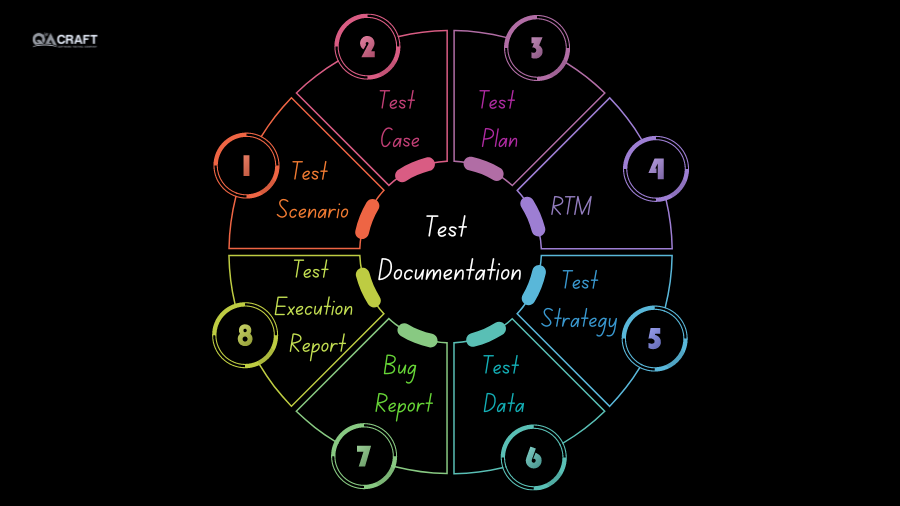Manual Testing, Software Testing
Test Documentation in Software Testing
- By Priyanka Kanthariya
- No Comments
25 Nov

Test Documentation is a document prepared by the QA team during or before the testing of software projects. Test document reflects the importance of the process for the customer, individual, and organization.
What is Test documentation in Software Testing?
Test documentation is a document that contains the Specification of a software project. It includes a Test plan, Test Case, Test Scenario, and Traceability Matrix.
Any project needs to have good test documentation. Good quality documentation reduces the cost, time, and effort of an organization.
Why Test Formality?
We can say that we are living in a digital era. We use mobile applications for primary requirements like Electricity bill payment, G-Pay, Paytm, and online shopping. so this thing needs to be tested properly then only it can be useable.
So after the development of the software, the next phase is to test formality to make sure that the particular project is working fine as per specification.
Examples of Test Documentation

Test Scenario: This document describes the various scenarios of the application to test. It helps to understand the flow of the application. It does not consist of any input data and navigation steps.
Test Case: A test case is a very descriptive test document. It consists of input data and navigation steps to test data. It also contains expected results and actual results for a clear understanding of the application’s working status.
Test Plan: A test plan is a test document prepared by the test lead or manager. The test plan consists of all activities for testing an application. There are multiple components of a Test plan (Test Environments, Test methodology, Template, Role and responsibility, Effort estimation, Objectives, Scope, Approach, Entry and Exit criteria, Schedule, Tools, Defect tracking, Test Deliverable, Assumption, Risk, and Mitigation Plan or Contingency Plan.)
Requirement Traceability Matrix(RTM): RTM stands for Requirement traceability matrix. RTM makes sure that all the test cases have been covered. RTM is used to ensure that we have not missed any particular requirement or test cases to execute in an application.
Test strategy: Test strategy Is a very important document for the testing process. It describes what kind of technique has been used for testing particular applications and which module going to be tested. It consists of multiple components test processes, scope, customer communication strategy, documentation formats, and objectives.
Test Data: Test data is a document that is created before test execution starts. Test data is used while implementing test cases. Test data is an Excel document prepared manually.
Bug Report: The “Bug Report” is a document that consists of details of all the bugs that occurred during the testing procedure. It is a very important document for developers and the QA team because by referencing this document team can track the process of a project. Using this document team came to know the number of open issues, solved issues, worked under process issues, Rejected issues, and solved issues.
Test Execution Report: The test lead prepares the “Test Execution Report” after the test execution process is completed. It defines the constancy of the project. It has information like the module, the number of written test cases, the number of passed test cases, number of failed test cases.
Best Practice to Achieve Test Documentation
- Involve the QA team from the beginning of the project so that testing documents can be prepared in parallel.
- Regularly update the test document as the testing procedure is proceeding.
- Verify the test document after the testing process is completed.
Advantages of Test Documentation
- Test document is important to reduce or remove uncertainties about the testing procedure.
- Test document is helpful to follow one structure for testing an application and it is helpful to fresher for training purposes.
- A mature test document is important to prepare a bug-free product within the specified time limit.
- Using the test document QA team becomes very clear about the required configuration of the system for testing any particular application.
- It helps to establish a transparent relationship between the client and the team.
Disadvantages of Test Documentation
- Sometimes it is a time-consuming task for the QA team to prepare test documents.
- Sometimes it is written by people who are not good writers so it becomes difficult to understand the content by other team members.
- Sometimes it is difficult to make up-to-date test documents as per the client’s requirements.
- If the quality of the document is not good then it creates a misunderstanding between the client and the team.
Conclusion:
Test documents have merits and demerits. But the thing is it is good practice to prepare test documents for software projects. Because it takes some time to prepare documents. Once the document is prepared with good quality, it is helpful throughout the journey of development.
Read Also:
I am Priyanka Kantharia. I am working as a Software Test Engineer at QACraft. My Qualification is MCA. I have 4 years of work experience as a QA. My hobbies are watching movies, and listening music.
Related Post
Categories
- Agile Testing
- Agile Testing
- Android App Testing
- Automation Testing
- Banking Domain Testing
- Beta Testing
- cloud testing
- Corporate Life
- cross browser testing
- Cypress Testing
- Cypress Testing
- desktop testing
- Domain Testing
- E-commerce Website Testing
- E-learning App Testing
- Functional Testing
- Game Testing
- Healthcare Domain Testing
- Infographics
- Ios App Testing
- Jenkins
- JIRA
- Katalon
- Manual Testing
- Mobile App Testing
- monkey testing
- Performance Testing
- Regression Testing
- Salesforce Testing
- security testing
- Selenium
- Selenium
- Software Testing
- static testing
- Test Environments
- vdfv
- Web Application Testing
© Copyright 2024 QACraft Pvt. Ltd. All rights reserved.
Contact : +91 9157786796






Priyanka Kanthariya